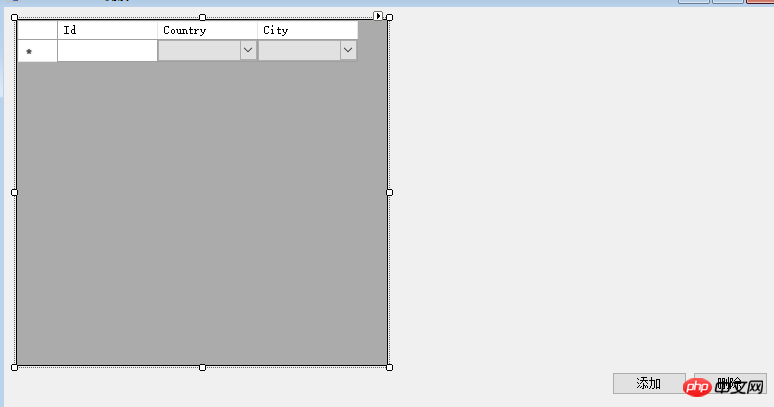Maison >développement back-end >Tutoriel C#.Net >Comment implémenter l'ajout, la suppression et la modification de DataGridView ?
Comment implémenter l'ajout, la suppression et la modification de DataGridView ?
- 零下一度original
- 2017-06-24 09:31:033858parcourir
1, créez une application de formulaire winform
2, faites glisser le contrôle DataGridView dans l'interface 
3, ajoutez les colonnes correspondantes comme indiqué : 

4, commencez à écrire le code suivant :
private DataTable CountryDt = new DataTable();
private DataTable CityDt = new DataTable();
public Main( )
InitializeComponent (); ", "CN|2|Tianjin", "CN |3|Shanxi", "JP|4|Osaka", "JP|5 |Yokohama", "JP|6|Nagoya", "JP|7|Kobe", "US|8|New York"
, , , , , "US|9|Los Angeles", "US|10|Chicago", "US|11|Houston", "US|12|Philadelphie", "US|13|San Francisco"};
CityDt.Columns.Add("cityName");
CityDt.Columns.Add("Pid");
for (int i = 0; i < villes.Longueur; i++)
{
newRow["cityCode"] = villes[i].Split('|')[1];
🎜> 🎜> private void InitCountryDt ()
{
string[] country = { "CN|Chine", "JP|Japon", "US|United States" };
CountryDt. Columns.Add("countryCode");
CountryDt.Columns.Add("countryName");
for (int i = 0; i < country.Length; i++)
{
var newRow = CountryDt.NewR ow();
newRow["countryCode"] = country[i].Split('|')[0];
newRow["countryName"] = country[i].Split ('|')(1];
CountryDt.Rows.Add(newRow);
}
}
dt.Columns. > .Rows.Add(newRow);
}
dataGridView1.DataSource = dt;
}
private void btnAdd_Click (objet expéditeur, EventArgs e)
Tableau;
var newRow = dt.NewRow();
newRow["Id"] = dt.Rows.Count + 1;
dt.Rows.Add(newRow);
< 🎜> countryCell. ValueMember = "countryCode";
countryCell.DisplayMember = "countryName";
dataGridView1.Rows[i].Cells["countryCode"] = countryCell;
}
}
private void dataGridView1_CellValueChanged (expéditeur de l'objet, DataGridViewCellEventArgs e)
{
var dt = this.dataGridView1.DataSource as DataTable;
if (dataGridView1.Columns[e.ColumnIndex].Name == nomde(CountryCode))
var countrycode = dataGridView1.Rows [e.rowIndex] .Cells [e.ColumnIndex] .Value;
var drs = citydt.select ("pid = '" + countrycode + "'") ;
var newCityDt = new DataTable();
newCityDt.Columns.Add("cityCode");
newCityDt.Columns.Add("cityName");
newCityDt.Columns.Add(" Pid");
foreach (ligne DataRow en drs)
{
var newRow = newCityDt.NewRow();
newRow["cityCode"] = row["cityCode"];
newRow["cityName"] = row["cityName"];
newRow["Pid"] = row["Pid"];
newCityDt.Rows.Add(newRow);
}
var cityCell = new DataGridViewComboBoxCell();
cityCell.DataSource = newCityDt;
cityCell.DisplayMember = "cityName";
cityCell.ValueMember = "cityCode";
dataGridView1.Rows[e .RowIndex].Cells["CityCode"] = cityCell;
}
private void Main_Load (expéditeur de l'objet, EventArgs e)
{
var vdt = data GridView1.DataSource comme DataTable;
pour (int i = 0; je &Lt ; vdt.Rows.Count ; i++)
var cell = new DataGridViewComboBoxCell()
{
DisplayMember = "countryName",
ValueMember = "countryCode",
DataSource = CountryDt
};
<> i].Cellules["CountryCode" ].Value = "JP";
dataGridView1.Rows[i].Cells["CityCode"].Value = new Random().Next(4, 7);
>
//else {
// dataGridView1.Rows[i].Cells["CountryCode"].Value = "CN";
//}
if (i % 5 == 0)
{
dataGridView1.Rows[i].Cells["CountryCode"].Value = "CN";
dataGridView1.Rows[i].Cells["CityCode"].Value = new Random().Next(1, 3) ;
}
if (i % 9 == 0)
{
dataGridView1.Rows[i].Cells["Count ryCode"].Value = "US";
dataGridView1.Rows [i].Cells["CityCode"].Value = new Random().Next(8, 13);
}
}
}
private void btnRemove_Click (expéditeur de l'objet, EventArgs e)
{
var dt = dataGridView1.DataSource as DataTable;
if (selected.Count > 0)
for (var i = 0; i < selected.Count; i++)
{
var row = selected[i];
dt.Rows.RemoveAt(ligne .Index);
}
}
}
Ce qui précède est le contenu détaillé de. pour plus d'informations, suivez d'autres articles connexes sur le site Web de PHP en chinois!

